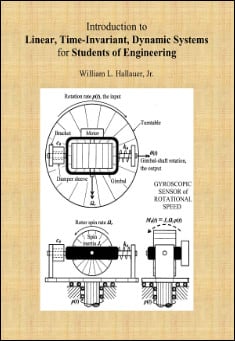Note: large file 4.4mb. Please ensure you have a suitable Internet connection.
This is a complete college textbook, or workbook, including a detailed Table of Contents, seventeen Chapters (each with a set of relevant homework problems), a list of References, two Appendices, and a detailed Index. The book is intended to enable students to:
Solve first, second, and higher-order, linear, time-invariant (LTI) ordinary differential equations (ODEs) with initial conditions and excitation, using both time-domain and Laplace-transform methods;
- Solve for the frequency response of an LTI system to periodic sinusoidal excitation and plot this response in standard form;
- Explain the role of the time constant in the response of a first-order LTI system, and the roles of natural frequency, damping ratio, and resonance in the response of a second-order LTI system;
- Derive and analyze mathematical models (ODEs) of low-order mechanical systems, both translational and rotational, that are composed of inertial elements, spring elements, and damping devices;
- Derive and analyze mathematical models (ODEs) of low-order electrical circuits composed of resistors, capacitors, inductors, and operational amplifiers;
- Derive (from ODEs) and manipulate Laplace transfer functions and block diagrams representing output-to-input relationships of discrete elements and of systems;
- Define and evaluate stability for an LTI system;
- Explain proportional, integral, and derivative types of feedback control for single-input, single-output (SISO), LTI systems;
- Sketch the locus of characteristic values, as a control parameter varies, for a feedback-controlled SISO, LTI system;
- Use MATLAB as a tool to study the time and frequency responses of LTI systems.
Excerpt:
The general minimum prerequisite for studying this book is the intellectual maturity of a junior-level (third-year) college student in an accredited four-year engineering curriculum. More specifically, a reader of this book should already have passed standard first courses in engineering dynamics and ODEs. It will be helpful if, but probably is not mandatory that, the reader has studied basic electrical circuits, perhaps in an introductory college physics course. It is necessary that the reader has studied basic computer programming. MATLAB computer programs and commands appear throughout this book, so the reader should be able to understand MATLAB commands. However, MATLAB commands are generally clearly expressed in standard English and standard arithmetic notation, so a person who has done any computer programming, even if that was not with MATLAB, probably can follow the computer commands and command sequences in this book. Familiarity with matrix notation and matrix arithmetic operations also will be helpful, especially for Chapters 11 and 12. My students who took at the same time AOE 3034 and a mathematics course on operational methods (primarily Laplace transforms) often found that the combination of those courses was unusually complementary and beneficial to their comprehension of the material.
A mathematical second-order system is represented in this book primarily by a single second-order ODE, not in the state-space form by a pair of coupled first-order ODEs. Similarly, a two-degrees-of-freedom (fourth-order) system is represented in Chapters 11 and 12 by a pair of coupled second-order ODEs, not in the state-space form by four coupled first-order ODEs. A reader who can understand the mathematics and dynamics of relatively simple systems expressed here in classical second-order form probably will have little trouble making the transition in more advanced literature to the general state-space representation of higher order systems.
This book deals mostly with specific idealized models of basic physical systems, such as mass-damper-spring mechanisms and single-loop electrical circuits. The emphases are on fundamental ODEs and fundamental system response characteristics. I have chosen, therefore, not to burden the reader with bond graph modeling, the general and powerful, but complicated, modern tool for analysis of dynamic systems. However, the material in this book is an appropriate preparation for the bond graph approach presented in, for example, System Dynamics: Modeling, Simulation, and Control of Mechatronic Systems, 5th edition, by Dean C. Karnopp, Donald L. Margolis, and Ronald C. Rosenberg.




